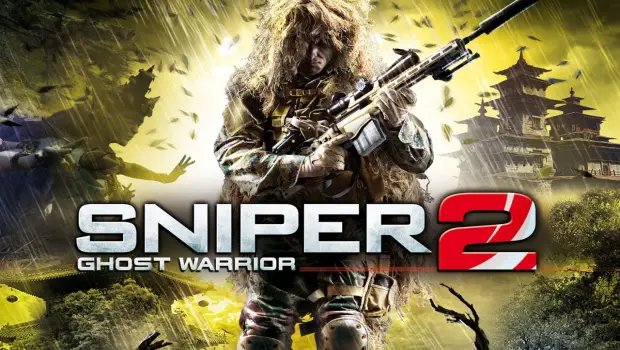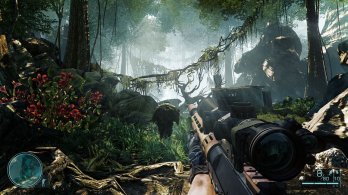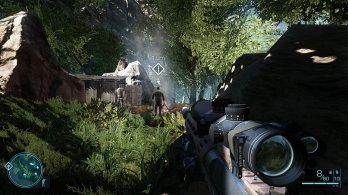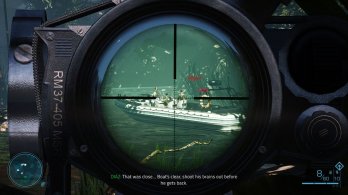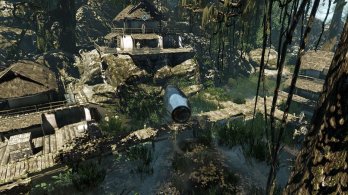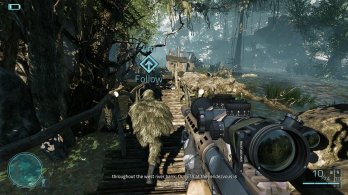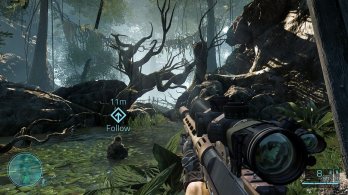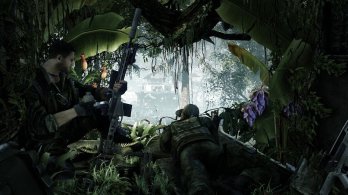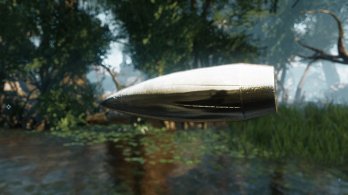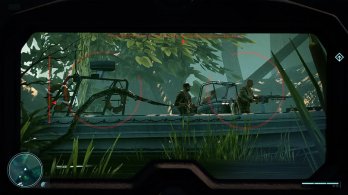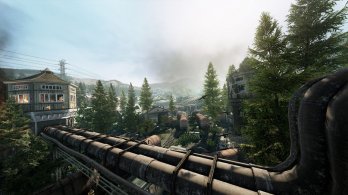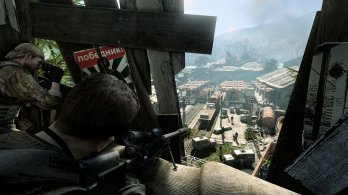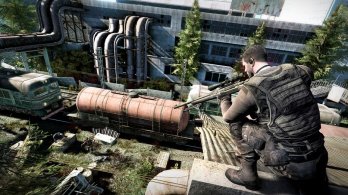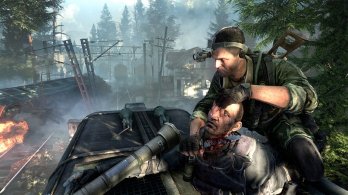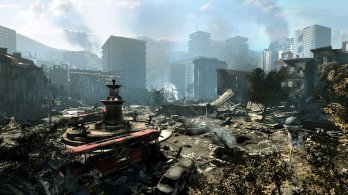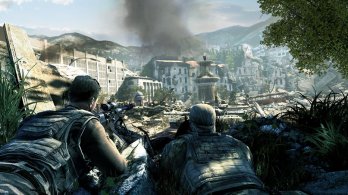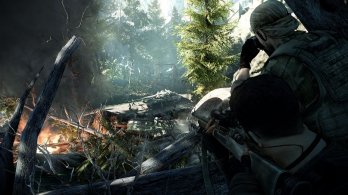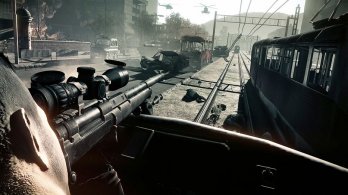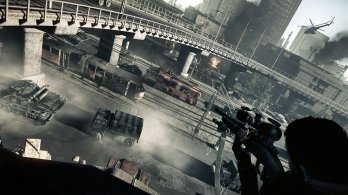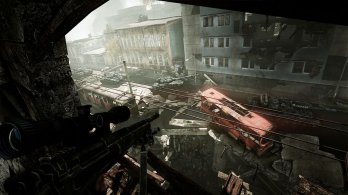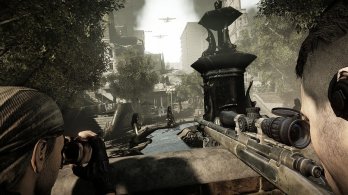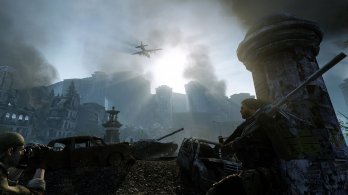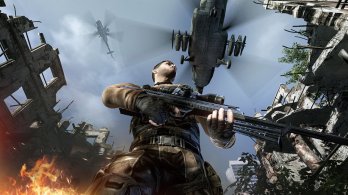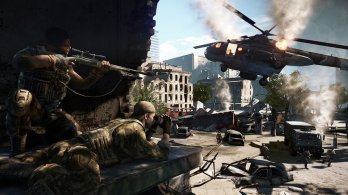
I spent 6 years in the military, with a good chunk of it being behind the scope. Some of the GT forum members have gone shooting with me in real life and know that I love rifles. Unfortunately, as a gamer, I hate the sniping experiences in most shooters. They fail to take into account the science of shooting, the adjustments needed for the all-important cold barrel shot, and the pairing of shooter and spotter. I recently got a title that aims to take that experience and make it the centerpiece of the entire game – Sniper: Ghost Warrior 2. I never played the original, so I had no idea what to expect. Let’s get a good cheek weld, steady our breathing and send it downrange to see what we can hit.
As I mentioned, I never played the first Sniper title, so I jump directly into the boots of Private Security Consultant Captain Cole Anderson without knowing the backstory. The game is fairly straightforward, dropping us in the jungle with our spotter. Through the story you’ll end up tackling lush vegetation, semi-urban environments, and even a dash of mountainous regions. Obviously this covers our most recent conflicts in the real world. The idea is that this would change your ghillie and stalk techniques, but in practicality is has little effect.
The story itself is fairly standard fare. Having spent quite a bit of time in-country, I can vouch that I never had to deal with any bloated gasbags like General Miller – the Commander who drones incessantly during the mission briefings and occasionally mid-mission. The narrative stitches the environments together loosely, but I think the team at City Interactive are aware of that – they chose to focus more on the gun dynamics than the story.
2,815 m – M82A1
[singlepic id=11308 w=320 h=240 float=left]There is a certain balance that has to be struck with shooters. Straight simulation of sniping would make most players completely bored to tears as the job involves weeks of planning, sitting, being patient, and slowly crawling, punctuated by 30 seconds of entirely too much excitement. A steady squeezing pressure on the trigger, bottoming your breath out in your lungs, and then letting the weapon system do all the work is the essence of your shot, but there is a great deal of math involved in hitting your target that occurs behind the scenes. Checking ballistic tables, firing a fouled or unfouled barrel, calculating your range come-ups, wind tables, mildot hold-offs and adjusting against established zeros (usually 200 and 500 meters) and proper breath control is critical to landing the only shot that matters – the first one. Naturally this is a bit much for a game, so all of this has been simplified to five calculations – distance, wind speed and direction, bullet drop compensation, breathing, and heart rate. That’s far more than most shooters, so the question is how all of it blends together.
Obviously your heartbeat and breathing has an effect on the movement of your weapon. Running and swimming causes your heart to race, and clearly my soldier needs to hit the gym as a short sprint or a dip in a stream nearly tripled it, causing him to swing his weapon wildly. Thankfully slowing down or stopping makes that heartrate fall back to normal rather quickly, giving you more stability for your shot. More often than not you’ll post up on a perch while your heartrate is already low, so this turns out to be less of a factor than you might think.
Bullet drop, wind speed and direction, and distance end up being the biggest factors in putting rounds on target. Longer shots when coupled with wind may require you to come down two mildots and over two opposite of the wind to hit your target. These minute details make all the difference and bridge the gap between science, math, and intuition. Breath control takes the game into an eyebrow-raising place that’s meant to be simulated concentration – slow motion. On higher difficulties the game will shorten the span of the time slow, or eliminate it completely.[singlepic id=11327 w=320 h=240 float=right]
Difficulty Matters
Taking shots at long distances is a difficult proposition. This game tries to make that easier by essentially calling your shots for you. On normal difficulty, if you wait just a moment the game will calculate the shot, giving you a red-dot indicator of where you should place the reticule. (though there are new specialty rifles that run on Linux that can do this and more ****LINK HERE***) Additionally, your spotter or people on the ground will put a visual target indicator over the a tango’s head. This takes a lot of the real-life guesswork out of shooting as well as target selection, and unfortunately some of the steam with it. It isn’t until you move to Expert mode that many of these hints are removed, more closely resembling real-life shooting.
There is one major thing that did stick in my craw a bit. The game does feature the .50cal fairly prominently, and having fired one extensively in my professional as well as personal life, I can assure you that even ball rounds will do an incredible amount of damage, ripping through nearly anything it encounters. For frame of reference, we put a hard drive against a steel I-beam and then shot it from about 250 meters. The round cut through the drive, then punched through the leaves as well as the center of the beam, digging into the mountain behind it with a solid thud. You can imagine how surprised I was when my rounds wouldn’t penetrate a simple wooden handrail in Sniper: Ghost Warrior 2. The game will occasionally give you shots you’d never take in real life, asking you to shoot two enemies at the same time. Conversely, common shots like snipers perched in front of a 2nd story balcony can often escape their fate by hiding behind a wooden handrail. Put simply, the bullet penetration is inconsistent.
There is one thing in the real world that is not inconsistent – what a .50 caliber round will do to a human body. If you want a fairly accurate representation, watch the most recent Rambo movie. When the sniper begins ripping off rounds at close range and body parts start coming loose, or people being hit in the chest go flying like ragdolls, you have an idea of what 647 grains of power will do to a man. Somehow, that didn’t make it into this title. Hitting enemies in the head or chest will kill anyone you hit at any range, but hitting somebody in the arm will only stumble them. Enemies will pop back up and begin firing your direction without ill effect. For a game that focuses a lot on realism, they seemed to have shied away from the incredible destructive power of this weapon system.
[singlepic id=11314 w=320 h=240 float=left]There is an advertised feature for the game that didn’t quite deliver on its promise, but not the way you think – namely the advanced AI. Enemies are obviously scripted and do seek cover when you are discovered, but they are also omnipotent and know exactly where you are at all times once you break stealth. Unfortunately the AI’s ability to track you is a little too advanced. On the other hand, the voice script is just dumb. I’ve already mentioned that your commander is ridiculous, but it was my spotter that drove me nuts. Staying in cover is all about disturbing the foliage as little as possible, and moving through vegetation causes a lot of unnatural movement that immediately catches the eye. My spotter must have been absent on the day they taught stalking, so often he’ll suggest paths that have you shoving through giant banana leaves. Most people would likely not notice it, but any countersniper that isn’t asleep at his post could see it from a mile away.
Short and sweet
Being a Combat Controller, a Ranger, a Seal, or any other Tier 1 operator means carefully stalking, selecting, and prosecuting your target and then quietly slipping away. Sniper: Ghost Warrior 2 attempts to tackle the heart of that experience and wrap a game around it. Seeing the slow-motion shots land on their targets is kinda cool, and the Crytek 3 engine does make the presentation beautiful. The multiplayer experience has died on launch with a maximum of only 8 people total playing on Steam, (and all but 2 of them in private locked games) but given that Deathmatch and Team Deathmatch are the only options, it comes as no surprise. The title retails on Steam for $29.99, and for a 4 hour single player experience that’s $7.50 per hour. While some aspects of the game are worthwhile on higher difficulty settings, the hand holding on Casual and Medium is excessive. All in all I’m not disappointed with the title but it will sit on the shelf next to a lot of others that came close, but didn’t quite pull it together to make it something great.

See below for our list of partners and affiliates:
